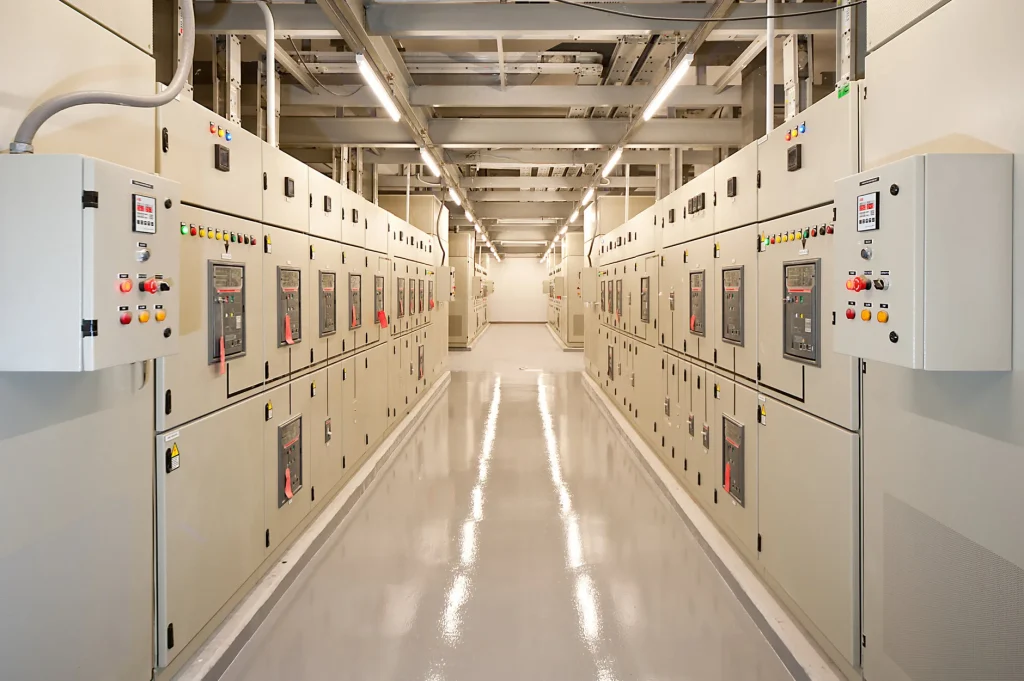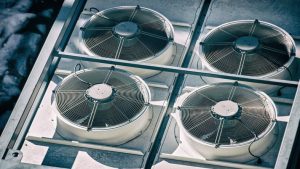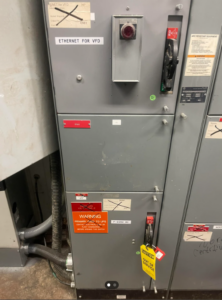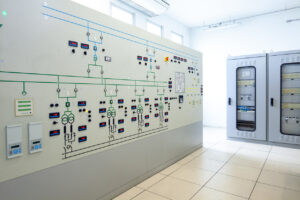Medium voltage switchgear is essential for controlling and protecting electrical systems in various industrial, as well as commercial settings. In this article, we review what a medium voltage switchgear is, its various components, and also the common types.
What is Medium Voltage Switchgear?
Medium voltage switchgears isolate, protect, and control electrical distribution networks or equipment with ratings usually from 3 to 36 kV. Unlike high voltage switchgear, medium voltage switchgear is often factory-assembled. Thus, making it prominent in indoor installations with components like circuit breakers, relays, current and voltage transformers, and busbars enclosed in a metal housing. Moreover, these switchgears comply with IEC 62271-200 and IEC 62271-100 standards, which ensure safe operation. Common insulating mediums include air, oil, gas, or solid materials. MV switchgear are common in manufacturing facilities, power distribution networks, and renewable energy plants.
Medium Voltage Switchgear Operation
Medium voltage switchgear operate by managing the flow of electrical power within a network, ensuring safe and reliable distribution. When a fault or abnormal condition occurs, the relays detect the issue and signal the circuit breaker to open, interrupting the flow of electricity. As a result, this prevents damage to the network and protects connected equipment. The switchgear can be manually or automatically operated, depending on the system’s design. The switchgear also allows for the safe isolation of sections of the network for maintenance or emergencies.
Typical Components of a Medium Voltage Switchgear
The switchgear is able to perform its function due to its components which the following sections highlight.
Circuit Breakers
Circuit breakers interrupt the electrical current in a circuit to isolate the system or equipment in case of faulty conditions. For example, during a short circuit or overcurrent. The current relay sends the information while the control unit triggers the breakers. So, breakers allow the opening and closing of the electrical circuit to regulate the specified current flows. Meanwhile, they are enclosed inside a compartment with insulating media such as air and gas.
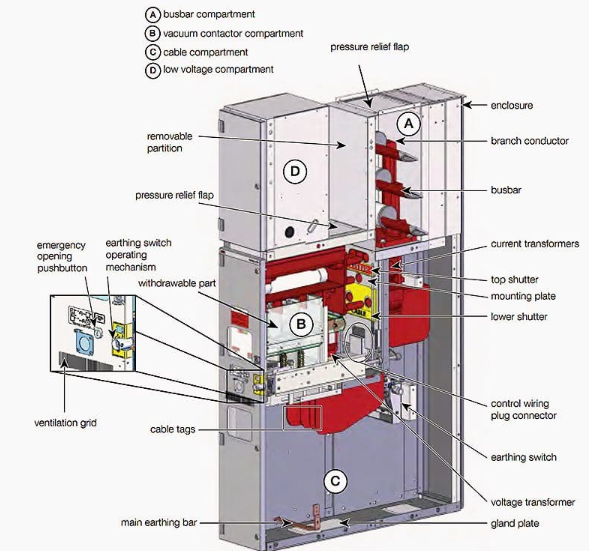
Fuses
A fuse is a thin wire connected with the circuit breakers, typically made with lead and tin alloy material. If the medium voltage switchgear receives any overload beyond the rated current and voltage, then it melts. Thus, disrupting current flow.
Relays
Relays send fault signals to circuit breakers to isolate the system and also provide data to control panels for regulation purposes. Generally, they connect two circuits (primary and secondary) and are responsible for monitoring, diagnostics, and control. A medium voltage switchgear includes overcurrent, differential, distance, voltage, or relays depending on the specific application requirements. Consequently, common types of relays are electromagnetic, solid-state, etc.
Busbars
Busbars play a pivotal role among medium voltage switchgear components. They are metallic strips or bars made of conductive materials such as copper or aluminum. In a medium voltage switchgear, busbars serve as the central node for power distribution. They function by carrying and distributing electrical power from incoming feeders to outgoing circuits, thus, ensuring a stable flow of electricity within the switchgear. Busbars are crucial for maintaining system efficiency, reducing energy losses, as well as ensuring the safe transmission of electricity across different components of the switchgear. Their robust design allows them to handle high current loads with minimal voltage drop.
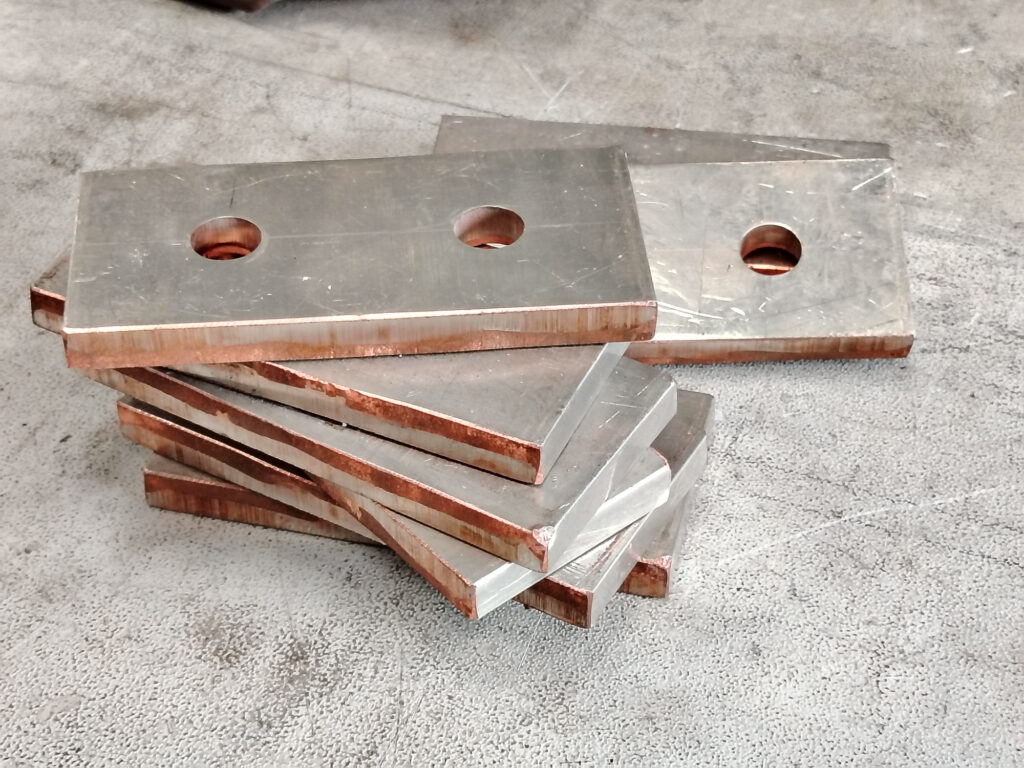
Isolators
The fault might occur in only one or a few specific circuits, so the isolator breaks them from healthy ones. They are typically connected to incoming and outgoing terminals of circuit breakers and react independently.
Disconnecting Switch
This switch provides a single button or interface to shut off the entire electrical system. In case of any downtime or maintenance, the disconnect switch facilitates the operation handling and safety.
Current and Voltage Transformers
Current and voltage transformers are critical medium voltage switchgear components because they serve to step down the current and voltage. They are installed around the cables or busbars, whereas the secondary winding is wired with the relays.
Surge Arrester
A surge arrester is for offering overvoltage protection to the system. Moreover, it diverts excess voltage to the ground and prevents possible damage. Medium voltage switchgear uses Metal Oxide Varistors (MOVs) that allow the flow of large currents during overvoltage conditions.
Automatic Shutter
The automatic shutter reconnects the components or specific compartments after the completion of fault repair. So, it helps to separate the faulty section from the healthy sections.
Types of Medium Voltage Switchgear
Classification of medium voltage switchgear is dependent on factors such as mounting type, enclosure type, and insulation type. The following sections highlight some of the common options.
Metal-clad MV Switchgear
It is a compact type of medium voltage switchgear that encloses all components inside a single enclosure. The main difference from the metal enclosure is that metal-clad type switchgear includes separate busbars and also cable compartments. Often, SF6 serves in the insulation of components with arc quenching capability. Also, other conventional mediums can serve like air and oil. The advantages of this type of switchgear are:
- Requires minimal space as well as offers a high degree of safety.
- Excellent protection against overload conditions.
- Integration of internal arc-quenching mechanisms is possible.
Pad Mounted MV Switchgear
Pad-mounted switchgear is installed at ground level on a concrete pad, typically used in outdoor environments. It is compact and enclosed in a tamper-resistant metal housing, thus, making it ideal for urban and suburban areas where space and safety are important. Some advantages of this type of switchgear are:
- Has a design that is suitable for installation in tight spaces without the need for additional structures.
- Fully enclosed, so protects components from weather, debris, and unauthorized access.
- Allows for quick and safe access to internal components for maintenance and repairs.
Metal Enclosure Switchgear
It is the most common MV switchgear structure that consists of encapsulation of different compartments by an external sheet metal enclosure. Although metal enclosure switchgear are often mistaken as metal-clad switchgear, they are fundamentally different. As a result, it is important to note this fact: “All metal-clads are metal enclosure switchgear but not all metal enclosure types are metal-clad switchgear”. The metal enclosure MV switchgears are suitable for simple power distribution networks and indoor installation.
- Generally, access is available from both front and back.
- Easy removal of CT’s and VTs
- The switch gear can be installed on the base plate or concrete
- Often designed as modular units, allowing for easy expansion and customization based on system requirements.
Other Types
Another important classification of switchgear is according to its insulation medium, as the following table highlights.
| Type of MV Switchgear | Insulating Medium | Key Characteristics |
| Gas Insulated Switchgear (GIS) | SF6, or mix of SF6 with other gasses | Fully enclosed and compact design because gas provides superior insulation strength. |
| Air Insulated Switchgear (AIS) | Air | An open design with larger breaker gaps. Does not require foreign material for insulation, so costs less than other insulation types. |
| Solid Dielectric Switchgear | Solid materials (porcelain, glass, etc.) | Robust construction and high durability. More common in high voltage switchgear. |
| Oil Insulated Switchgear | Oil | Good performance but with environmental trade-offs. |
| Arc Resistant Switchgear | Varies | It is specially designed to contain and extinguish arc flash incidents. |

